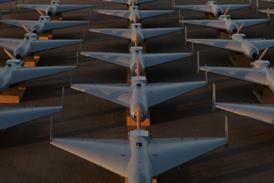Spectrum Astro is building three MightySat Phase 2 small satellites for the US Air Force Phillips Laboratory, which is managing its own version of NASA's New Millennium project . The work resumed in March 1996 after a suspension following the withdrawal of a bid protest by CTA Space Systems. The MightySat programme will provide frequent, low-cost access to space for the demonstration of emerging technologies developed by Phillips. The craft are designed as flying laboratory benches, enabling technologies to b e taken from development to operation.
The Spectrum Astro contract is worth $23.5 million through to 2005, if three additional optional satellites are also built.
The MightySats will carry two types of payloads - experimental bus components and stand-alone experiments. The first of the science experiments will include a new type of hyperspectral imager and a low-cost ultra-violet Sun-irradiance meter.
The MightySat work is a logical extension to Spectrum Astro's role in the MSTI programme, which gave birth to the New Millennium concept. The goal of the MSTI programme is to demonstrate and test miniature-sensor technologies for missile detection, using small low-Earth-orbiting satellites, with the secondary objective at gathering background data on the Earth's atmosphere.
The "faster, better, cheaper" approach was developed by Spectrum Astro, Phillips and JPL, which implemented the MSTI satellite design by adapting the results of Spectrum Astro's Advanced Satellite Subsystem Technology Demonstration design for the Defense Advanced Research Projects Agency. A key to the firm's success has been that spacecraft are of standard design so that any component can be removed and replaced easily and quickly.
The MSTI 1 was launched in 1992 and its major payload was a sensor which returned 100,000 mid-wave infra-red images, one of which revealed a rocket motor being ground-tested. The 225kg MSTI 3 was launched in May 1996, equipped with an improved imaging system.
Source: Flight International




















